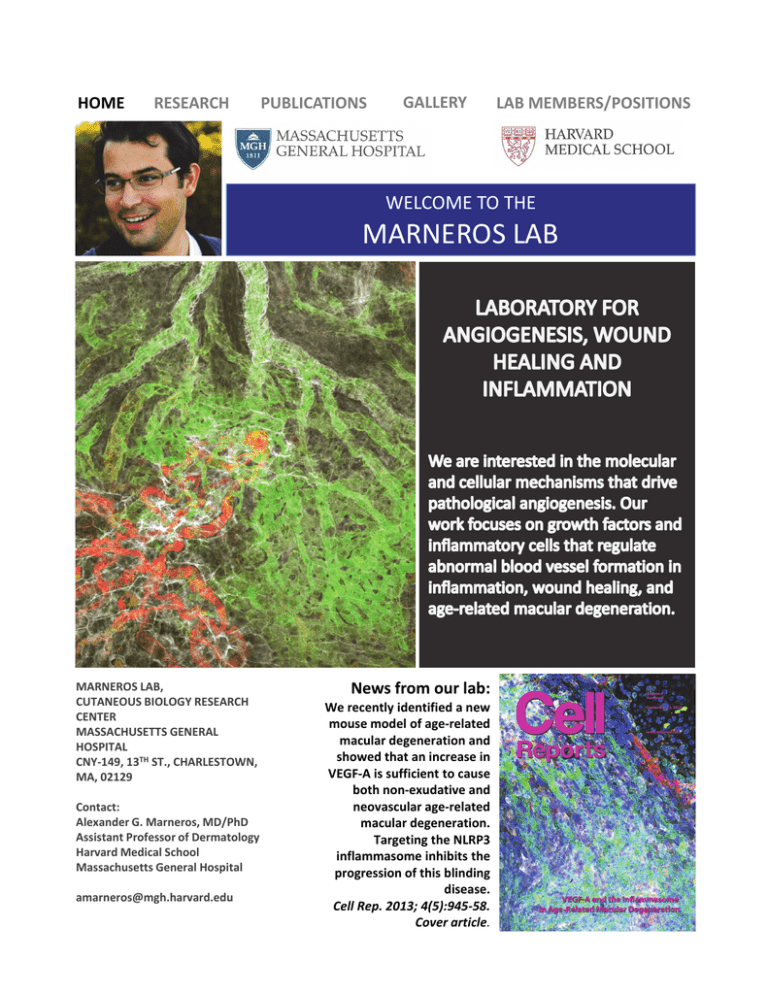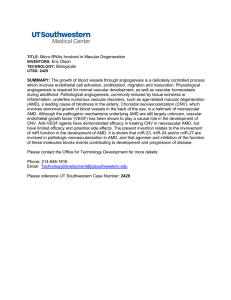marneros lab - Massachusetts General Hospital
advertisement

HOME RESEARCH PUBLICATIONS GALLERY LAB MEMBERS/POSITIONS WELCOME TO THE MARNEROS LAB MARNEROS LAB, CUTANEOUS BIOLOGY RESEARCH CENTER MASSACHUSETTS GENERAL HOSPITAL CNY‐149, 13TH ST., CHARLESTOWN, MA, 02129 Contact: Alexander G. Marneros, MD/PhD A i t tP f Assistant Professor of Dermatology fD t l Harvard Medical School Massachusetts General Hospital amarneros@mgh.harvard.edu News from our lab: We recently identified a new mouse model of age related mouse model of age‐related macular degeneration and showed that an increase in VEGF‐A is sufficient to cause both non‐exudative and neovascular age‐related macular degeneration. Targeting the NLRP3 i h L 3 inflammasome inhibits the progression of this blinding disease. Cell Rep. 2013; 4(5):945‐58. Cover article. HOME RESEARCH PUBLICATIONS GALLERY LAB MEMBERS/POSITIONS MARNEROS LAB Abnormal blood vessel growth is an important component in the pathogenesis of various common diseases. Pathological angiogenesis is stimulated by an i fl inflammatory response that involves many different cell types, including h i l diff ll i l di proangiogenic macrophages. Our laboratory focuses on the factors and cell types that promote pathologic angiogenesis in development, in the adult and during aging. 1. Flat mount of a choroidal neovascular lesion in mice with increased VEGF‐A levels. Macrophages (white) infiltrate sites of breakdown of the RPE barrier (red, beta‐catenin), resulting in neovascularization into the subretinal space (Cell Rep. 2013; 4(5):945‐58). ABNORMAL ANGIOGENESIS DURING AGING: AGE RELATED MACULAR DEGENERATION AGE‐RELATED MACULAR DEGENERATION. Age‐related macular degeneration (AMD) is the most common cause of irreversible blindness in the elderly. Non‐exudative (“dry”) AMD manifests with degeneration of the retinal pigment epithelium (RPE) and sub‐RPE deposit formation with progressive age Neovascular deposit formation with progressive age. Neovascular (“wet”) AMD manifests with pathologic neovascularization from the choroid into the retina. Often both forms co‐occur, suggesting a common pathomechanism. We have recently shown in a new mouse model of AMD that increased VEGF‐A is sufficient ,p g to cause both forms of AMD, providing evidence for a unifying pathomechanism in advanced AMD. In this model, proangiogenic macrophages stimulate retinal glia cells to promote choroidal neovascularization. Furthermore, we could show that the NLRP3 inflammasome promotes VEGF‐A‐induced AMD pathologies, and targeting inflammasome components inhibits these pathologies. Our work focuses on elucidating the mechanisms that regulate molecular pathways and cellular interactions during AMD pathogenesis, with the aim of identifying novel therapeutic approaches for patients with AMD. HOME RESEARCH PUBLICATIONS GALLERY LAB MEMBERS/POSITIONS MARNEROS LAB Cre‐iDTR + DT Laser‐induced choroidal neovascularization is promoted by activated macrophages. Targeted ablation of macrophages inhibits neovascularization (CD31+ vessels in green) in response to laser g ) p injury (Am J Pathol. 2013; 182(6):2407‐17; Cell Rep. 2013; 4(5):945‐58). SMA/CD D31/F4/80(white) LysMCre+iDTR + DT 2. ROLE OF MACROPHAGES IN ANGIOGENESIS AND THE WOUND HEALING RESPONSE. AND THE WOUND HEALING RESPONSE. Multiple cell types interact in a highly coordinated fashion in response to injury to promote wound healing. Abnormalities in this complex process can result in exuberant wound angiogenesis or scarring. We use in vivo models of wound healing to determine the spatiotemporal contributions of various cell types in this process. In a laser‐injury model of choroidal neovascularization, we could show that macrophages become alternatively activated (M2‐type) and promote wound angiogenesis, in part by stimulating retinal glia cells to express proangiogenic growth factors. Specific ablation of macrophages inhibits the early wound healing response to injury and blocks wound angiogenesis. Our current research investigates which signaling pathways drive polarization of macrophages to the proangiogenic M2‐type in vivo and how this polarization can be inhibited Overall we aim to define the contributions inhibited. Overall, we aim to define the contributions of individual inflammatory cell populations to wound healing and neovascularization. HOME RESEARCH PUBLICATIONS GALLERY LAB MEMBERS/POSITIONS MARNEROS LAB 3. Autosomal dominant aplasia cutis congenita is caused by a mutation in the ribosomal biogenesis GTPase BMS1. The mutation results in a maturation defect of the small ribosomal subunit and a p21‐mediated nucleolar stress response that leads to a reduced cell proliferation rate (PLoS Genet. 2013; 9(6):e1003573). REGULATION OF SKIN FORMATION DURING DEVELOPMENT: CAUSES OF CONGENITAL WOUNDS. Wound healing and wound angiogenesis occur in response to injury. However, congenital wounds are observed in various genetic syndromes as a if t ti f ki h i d f td i manifestation of a skin morphogenesis defect during embryonic development. Identifying the genetic basis for these conditions and syndromes promises to identify novel genes and pathways that are critical for proper skin formation and whose impairment results in wounds. A prototypical congenital skin disease that manifests with a wound present at birth is aplasia cutis manifests with a wound present at birth is aplasia cutis congenita (ACC). Using a combination of genome‐wide linkage analysis and exome sequencing we recently identified the causative mutation for ACC. We found that the ribosomal GTPase BMS1 is mutated in ACC, which results in a maturation defect of the small ribosomal subunit and leads to a nucleolar stress response with a p21‐mediated G1/S phase transition delay and a reduced cell proliferation rate. Global proteomic and transcriptional analyses revealed a central role of p21 activation for the ACC phenotype. Our laboratory investigates how a mutation in a ubiquitous ribosomal protein leads to localized skin defects without affecting other organ systems. We seek to obtain a comprehensive understanding of the disease mechanisms of congenital wound healing disorders. HOME RESEARCH PUBLICATIONS GALLERY LAB MEMBERS/POSITIONS MARNEROS LAB 1. Marneros AG. NLRP3 Inflammasome Blockade Inhibits VEGF‐A‐Induced Age‐Related Macular Degeneration. Cell Reports, 2013, 4(5): 945‐958. Cover article. 2. He L and Marneros AG. He L and Marneros AG. Macrophages are essential for the early wound healing response Macrophages are essential for the early wound healing response and and the formation of a fibrovascular scar. Am J Pathol, 2013, 182(6):2407‐17. Cover article. 3. Marneros AG. BMS1 is mutated in Aplasia Cutis Congenita. PLoS Genetics, 2013, 9(6):e1003573. 4. Marneros AG*, Beck AE*, Turner EH*, McMillin MJ, Edwards MJ, Field M, de Macena Sobreira NL, Perez AB, Fortes JA, Lampe AK, Giovannucci Uzielli ML, Gordon CT, Plessis G, Le Merrer M, Amiel J, Reichenberger E, Shively KM, Cerrato F, Labow BI, Tabor HK, Smith JD, Shendure J, Nickerson DA, Bamshad MJ; University of Washington Center for Mendelian Genomics. Mutations in KCTD1 cause Scalp‐Ear‐Nipple Syndrome. Am J Hum Genet, 2013, 92(4):621‐6. *equal contribution. 5. Makinodan E and Marneros AG. Protein kinase A activation inhibits oncogenic Sonic hedgehog signalling and suppresses basal cell carcinoma of the skin. Exp Dermatol, 2012, 21(11):847‐52. 6. Marneros AG, Blanco F, Husain S, Silvers DN, Grossman ME. Classification of cutaneous i intravascular breast cancer metastases based on immunolabeling l b b d i l b li for blood and lymph vessels. J f bl d d l h l J Am Acad Dermatol. 2009;60(4):633‐8. 7. Marneros AG, Grossman ME, Silvers DN, Husain S, Nuovo GJ, MacGregor‐Cortelli B, Neylon E, Patterson M, O'Connor OA, Zain JM. Pralatrexate‐induced tumor cell apoptosis in the epidermis of a patient with HTLV‐1 adult T‐cell lymphoma/leukemia causing skin erosions. Blood, 2009, 113(25):6338‐41. 8 Marneros AG, She H, Zambarakji 8. Marneros AG She H Zambarakji H, Hashimoto H, Connolly E, Kim I, Gragoudas H Hashimoto H Connolly E Kim I Gragoudas E, Miller JW, E Miller JW Olsen BR. Endogenous endostatin inhibits choroidal neovascularization. FASEB J, 2007, 21(14):3809‐3818. 9. Marneros AG, Fan J, Yokoyama Y, Gerber HP, Ferrara N, Crouch, RK, Olsen BR. VEGF expression in the retinal pigment epithelium is essential for choriocapillaris development and visual function. Am J Pathol, 2005;167: 1349‐1357. 10. Marneros AG, Keene DR, Hansen U, Fukai Marneros AG, Keene DR, Hansen U, Fukai N, Moulton K, Goletz N, Moulton K, Goletz PL, Moiseyev PL, Moiseyev G, Pwalyk G, Pwalyk BS, BS, Halfter W, Dong S, Shibata M, Li T, Crouch RK, Bruckner P, Olsen BR. Collagen XVIII and endostatin are essential for vision and retinal pigment epithelial function. EMBO J., 2004;23(1):89‐99 For the full publication list, search Pubmed for Marneros AG[au] HOME RESEARCH PUBLICATIONS GALLERY LAB MEMBERS/POSITIONS MARNEROS LAB Lipid‐like sub‐RPE deposits in VEGF‐A‐induced AMD Increased VEGF‐A causes age‐dependent choroidal neovascularization HOME RESEARCH PUBLICATIONS GALLERY LAB MEMBERS/POSITIONS MARNEROS LAB Lizhi (Justin) He, PhD: Mariya Marioutina, B.Sc.: Jaclyn Andricovich, B.Sc.: postdoctoral research fellow research technician research technician A position for a highly dedicated and qualified postdoctoral research fellow is currently available. Please contact Alexander Marneros: amarneros@mgh.harvard.edu



